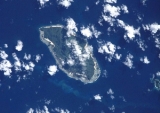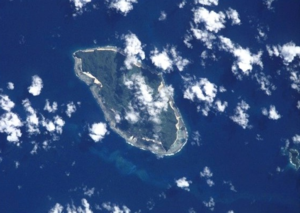
Taumako
Encyclopedia
Taumako is the largest of the Duff Islands
. This 5.7 km long island has steep sides and rises to a height of 400 m above sea level. It is composed of basaltic lavas and pyroclastics like the other islands in the Duffs .
 The inhabitants of the Duff Islands are Polynesians
The inhabitants of the Duff Islands are Polynesians
, and their language, Pileni
, is a member of the Samoic
branch of Polynesian languages
.
On the Duff Islands live about 439 people (1999 census). The islands were settled by the Lapita people about 900 BC. Melanesian settlers followed. Finally Polynesians settlers arrived in mid 1400's.
The way of life is traditional by subsistence farming and fishing. Taumako has no roads, airport, telephones, or electricity. Contact with outsiders comes by battery-powered marine radio and the occasional cargo ship.
and Marianne (Mimi) George uncovered that full traditional Polynesian navigational technique is still preserved in these islands (Finney and Lowe, 2006, p163). The people of Taumako are the builders of one of the oldest documented proa
sailing canoe, called Te Puke and known to westerners als Tepukei
.
style with dentate stamping. These first inhabitants made stone tools using high quality chert which was also local. This same chert has been found in archaeological sites in the nearby Reef Islands
, dating at least two centuries before the first known evidence in the Duff Islands (Leach and Davidson 2008: 295).
Later archaeological sites dating from AD 1,000 through to the 19th century contain a diverse range of personal ornaments, many of which are similar to those present in ethnographic collections from Santa Cruz displayed in numerous museums around the world. Several of these ornaments can now be shown to be present throughout the 3,000 years of their prehistory. Amongst these are the famous Tridacna shell breast pendants. Several specimens have imprints of fine loom woven cloth, representing the first unequivocal evidence for the presence of the loom in prehistoric Oceania (ibid.: 190).
Throughout Duff Islands prehistory there is clear archaeological evidence of contact with other Pacific Island peoples from as far afield as the Fiji-Samoa area. This is evident from stone adzes in these islands made from a form of basalt only found in the stone quarries of Tutuila in American Samoa. Most evidence of contact, however, is predictably from closer to Taumako, especially the nearby Santa Cruz
region. These wide-ranging external contacts have resulted in a population of people which shows a profound mixture of Melanesian and Polynesian
physical features (ibid.: 245).
Life in the Duff Islands
during the prehistoric period was far from idyllic with a high incidence of the infectious disease yaws. This affected children as well as adults and in later life was often debilitating (ibid.: 229). There is also archaeological evidence of inter-personal hostility with deaths being caused by spear wounds. Some of this may have resulted from warfare between different groups, either locally or with arrivals from further afield.
The first known European visit to the Duff Islands
was the expedition led by the Spanish explorer Quiros
in AD 1606. One of the late archaeological sites contained objects made from European materials. Amongst these, a piece of pottery has a mineralogy consistent with Spanish pottery of Quiros' period. In addition a small piece of brass has a chemical composition suggesting the same derivation (ibid.: 272).
Duff Islands
The Duff Islands are a small island group lying to the northeast of the Santa Cruz Islands in the Solomon Islands province of Temotu. They are also sometimes known as the Wilson Islands....
. This 5.7 km long island has steep sides and rises to a height of 400 m above sea level. It is composed of basaltic lavas and pyroclastics like the other islands in the Duffs .

Polynesians
The Polynesian peoples is a grouping of various ethnic groups that speak Polynesian languages, a branch of the Oceanic languages within the Austronesian languages, and inhabit Polynesia. They number approximately 1,500,000 people...
, and their language, Pileni
Pileni language
Vaeakau-Taumako is a Polynesian language spoken in some of the Reef Islands as well as in the Taumako Islands in the Temotu province of the Solomon Islands....
, is a member of the Samoic
Samoic languages
The Samoic–Outlier languages, also known as Samoic languages, are a purported group of Polynesian languages, encompassing the Polynesian languages of Samoa, Tuvalu, American Samoa, Tokelau, Wallis and Futuna, and Polynesian outlier languages in New Caledonia, the Solomon Islands, Vanuatu, Papua New...
branch of Polynesian languages
Polynesian languages
The Polynesian languages are a language family spoken in the region known as Polynesia. They are classified as part of the Austronesian family, belonging to the Oceanic branch of that family. They fall into two branches: Tongic and Nuclear Polynesian. Polynesians share many cultural traits...
.
On the Duff Islands live about 439 people (1999 census). The islands were settled by the Lapita people about 900 BC. Melanesian settlers followed. Finally Polynesians settlers arrived in mid 1400's.
The way of life is traditional by subsistence farming and fishing. Taumako has no roads, airport, telephones, or electricity. Contact with outsiders comes by battery-powered marine radio and the occasional cargo ship.
Traditional Navigation
Studies of David LewisDavid Henry Lewis
David Henry Lewis, DCNZM was a sailor, adventurer, doctor, and Polynesian scholar. He is best known for his studies on the traditional systems of navigation used by the Pacific Islanders...
and Marianne (Mimi) George uncovered that full traditional Polynesian navigational technique is still preserved in these islands (Finney and Lowe, 2006, p163). The people of Taumako are the builders of one of the oldest documented proa
Proa
A proa, also seen as prau, perahu, and prahu, is a type of multihull sailing vessel.While the word perahu and proa are generic terms meaning boat their native language, proa in Western languages has come to describe a vessel consisting of two unequal length parallel hulls...
sailing canoe, called Te Puke and known to westerners als Tepukei
Tepukei
A Tepukei is a very old Melanesian boat type, first reported by Spanish explorer Álvaro de Mendaña in 1595, on his visit to the Santa Cruz Islands...
.
Prehistory
People have been living in the Duff Islands for 3,000 years. The first people on these islands made pottery using clay and sand temper which was available locally. A small amount of this pottery was decorated in the distinctive LapitaLapita
Lapita is a term applied to an ancient Pacific Ocean archaeological culture which is believed by many archaeologists to be the common ancestor of several cultures in Polynesia, Micronesia, and some coastal areas of Melanesia...
style with dentate stamping. These first inhabitants made stone tools using high quality chert which was also local. This same chert has been found in archaeological sites in the nearby Reef Islands
Reef Islands
The Reef Islands are a loose collection of 16 islands in the northwestern part of the Solomon Islands province of Temotu. These islands have historically also been known by the names of Swallow Islands and Matema Islands....
, dating at least two centuries before the first known evidence in the Duff Islands (Leach and Davidson 2008: 295).
Later archaeological sites dating from AD 1,000 through to the 19th century contain a diverse range of personal ornaments, many of which are similar to those present in ethnographic collections from Santa Cruz displayed in numerous museums around the world. Several of these ornaments can now be shown to be present throughout the 3,000 years of their prehistory. Amongst these are the famous Tridacna shell breast pendants. Several specimens have imprints of fine loom woven cloth, representing the first unequivocal evidence for the presence of the loom in prehistoric Oceania (ibid.: 190).
Throughout Duff Islands prehistory there is clear archaeological evidence of contact with other Pacific Island peoples from as far afield as the Fiji-Samoa area. This is evident from stone adzes in these islands made from a form of basalt only found in the stone quarries of Tutuila in American Samoa. Most evidence of contact, however, is predictably from closer to Taumako, especially the nearby Santa Cruz
Santa Cruz Islands
The Santa Cruz Islands are a group of islands in the Pacific Ocean, part of Temotu Province of the Solomon Islands. They lie approximately 250 miles to the southeast of the Solomon Islands Chain...
region. These wide-ranging external contacts have resulted in a population of people which shows a profound mixture of Melanesian and Polynesian
Polynesians
The Polynesian peoples is a grouping of various ethnic groups that speak Polynesian languages, a branch of the Oceanic languages within the Austronesian languages, and inhabit Polynesia. They number approximately 1,500,000 people...
physical features (ibid.: 245).
Life in the Duff Islands
Duff Islands
The Duff Islands are a small island group lying to the northeast of the Santa Cruz Islands in the Solomon Islands province of Temotu. They are also sometimes known as the Wilson Islands....
during the prehistoric period was far from idyllic with a high incidence of the infectious disease yaws. This affected children as well as adults and in later life was often debilitating (ibid.: 229). There is also archaeological evidence of inter-personal hostility with deaths being caused by spear wounds. Some of this may have resulted from warfare between different groups, either locally or with arrivals from further afield.
The first known European visit to the Duff Islands
Duff Islands
The Duff Islands are a small island group lying to the northeast of the Santa Cruz Islands in the Solomon Islands province of Temotu. They are also sometimes known as the Wilson Islands....
was the expedition led by the Spanish explorer Quiros
Pedro Fernandes de Queirós
Pedro Fernandes de Queirós , was a Portuguese navigator best known for his involvement with Spanish voyages of discovery in the Pacific Ocean, in particular the 1595-1596 voyage of Alvaro de Mendaña de Neira, and for leading a 1605-1606 expedition which crossed the Pacific in search of Terra...
in AD 1606. One of the late archaeological sites contained objects made from European materials. Amongst these, a piece of pottery has a mineralogy consistent with Spanish pottery of Quiros' period. In addition a small piece of brass has a chemical composition suggesting the same derivation (ibid.: 272).

